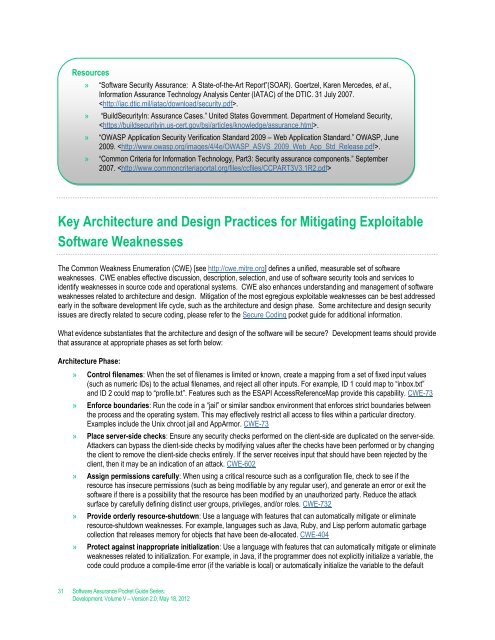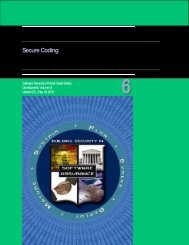Architecture and Design Considerations - Build Security In - US-CERT
Architecture and Design Considerations - Build Security In - US-CERT
Architecture and Design Considerations - Build Security In - US-CERT
Create successful ePaper yourself
Turn your PDF publications into a flip-book with our unique Google optimized e-Paper software.
Resources<br />
» “Software <strong>Security</strong> Assurance: A State-of-the-Art Report”(SOAR). Goertzel, Karen Mercedes, et al.,<br />
<strong>In</strong>formation Assurance Technology Analysis Center (IATAC) of the DTIC. 31 July 2007.<br />
.<br />
» “<strong>Build</strong><strong>Security</strong><strong>In</strong>: Assurance Cases.” United States Government. Department of Homel<strong>and</strong> <strong>Security</strong>,<br />
.<br />
» “OWASP Application <strong>Security</strong> Verification St<strong>and</strong>ard 2009 – Web Application St<strong>and</strong>ard.” OWASP, June<br />
2009. .<br />
» “Common Criteria for <strong>In</strong>formation Technology, Part3: <strong>Security</strong> assurance components.” September<br />
2007. <br />
Key <strong>Architecture</strong> <strong>and</strong> <strong>Design</strong> Practices for Mitigating Exploitable<br />
Software Weaknesses<br />
The Common Weakness Enumeration (CWE) [see http://cwe.mitre.org] defines a unified, measurable set of software<br />
weaknesses. CWE enables effective discussion, description, selection, <strong>and</strong> use of software security tools <strong>and</strong> services to<br />
identify weaknesses in source code <strong>and</strong> operational systems. CWE also enhances underst<strong>and</strong>ing <strong>and</strong> management of software<br />
weaknesses related to architecture <strong>and</strong> design. Mitigation of the most egregious exploitable weaknesses can be best addressed<br />
early in the software development life cycle, such as the architecture <strong>and</strong> design phase. Some architecture <strong>and</strong> design security<br />
issues are directly related to secure coding, please refer to the Secure Coding pocket guide for additional information.<br />
What evidence substantiates that the architecture <strong>and</strong> design of the software will be secure Development teams should provide<br />
that assurance at appropriate phases as set forth below:<br />
<strong>Architecture</strong> Phase:<br />
» Control filenames: When the set of filenames is limited or known, create a mapping from a set of fixed input values<br />
(such as numeric IDs) to the actual filenames, <strong>and</strong> reject all other inputs. For example, ID 1 could map to “inbox.txt”<br />
<strong>and</strong> ID 2 could map to “profile.txt”. Features such as the ESAPI AccessReferenceMap provide this capability. CWE-73<br />
» Enforce boundaries: Run the code in a “jail” or similar s<strong>and</strong>box environment that enforces strict boundaries between<br />
the process <strong>and</strong> the operating system. This may effectively restrict all access to files within a particular directory.<br />
Examples include the Unix chroot jail <strong>and</strong> AppArmor. CWE-73<br />
» Place server-side checks: Ensure any security checks performed on the client-side are duplicated on the server-side.<br />
Attackers can bypass the client-side checks by modifying values after the checks have been performed or by changing<br />
the client to remove the client-side checks entirely. If the server receives input that should have been rejected by the<br />
client, then it may be an indication of an attack. CWE-602<br />
» Assign permissions carefully: When using a critical resource such as a configuration file, check to see if the<br />
resource has insecure permissions (such as being modifiable by any regular user), <strong>and</strong> generate an error or exit the<br />
software if there is a possibility that the resource has been modified by an unauthorized party. Reduce the attack<br />
surface by carefully defining distinct user groups, privileges, <strong>and</strong>/or roles. CWE-732<br />
» Provide orderly resource-shutdown: Use a language with features that can automatically mitigate or eliminate<br />
resource-shutdown weaknesses. For example, languages such as Java, Ruby, <strong>and</strong> Lisp perform automatic garbage<br />
collection that releases memory for objects that have been de-allocated. CWE-404<br />
» Protect against inappropriate initialization: Use a language with features that can automatically mitigate or eliminate<br />
weaknesses related to initialization. For example, in Java, if the programmer does not explicitly initialize a variable, the<br />
code could produce a compile-time error (if the variable is local) or automatically initialize the variable to the default<br />
31 Software Assurance Pocket Guide Series:<br />
Development, Volume V – Version 2.0, May 18, 2012
















